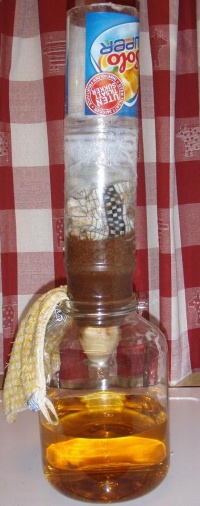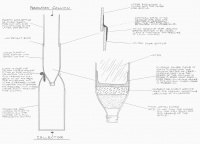The Herbal Percolator
About
The percolation method is a very simple and effective way of preparing teas from botanical materials such as caapi and mimosa. Although the basic principle of the percolation column is similar to the way most people brew their coffee, it does not require cooking. The percolation method was originally tried out on caapi, where the results have been excellent, even more so than with the regular 3 x 3 hour cooking method. Percolation works well with some admixture plants also. The jury is, however, still out on how effective it is in extracting viridis, which apparently requires hot water to get most of the actives out.
This method was created by Dagger
Creating The Herbal Percolator (THP)
What is needed
- A large plastic soda bottle.
- A jar
- Cotton.
- Two pieces of cloth.
- A blender to powder the material.
- A sharp knife.
Longer length
The longer length of the containers which can be seen in the picture and the drawing is not strictly necessary. However, a higher column makes it possible to add more water at a time, which also causes the water to move faster through the materials. The column can be made higher simply by cutting off the top and bottom of a second bottle and connecting the two with strong adhesive tape (see drawing).
How to make/use the setup
- Cut off the bottom of a plastic soda bottle with a sharp knife.
- When the bottle is ready, take a decent size lump of cotton and stuff it up into the neck of the bottle. This is the filter that will prevent particles from coming through.
- Pour a little water onto the cotton, enough to make it wet. Then gently push the cotton towards the neck of the bottle. Do not push the cotton all the way into the neck, as this will cause the liquid to move through at a slower pace. Adding water helps to compress the cotton.
- Add the herb you wish to extract on top of the cotton.
- Take a piece of cloth and push it down into the bottle so it presses up against the powdered herbs. The cloth needs to be large enough to push against the walls. This will prevent it from floating up when you add water.
- Put the bottle with the neck facing down into a jar that collects the percolated water.
- Take a small piece of cloth and put it in between the bottle and the jar, as seen in the picture and the drawing. This is done in order to let the air out of the collector as the brew flows in. If the joint is air tight, the flow of water will stop.
- Now it is time to add water. Warm water, around 60C/140F is preferable. Much warmer and the plastic bottle might buckle, unless it is heat resistant. Don't forget to add acid to the water. 15-30 ml of 5% vinegar per litre of water should be sufficient.
- As the water drips through, keep adding water at regular intervals.
- Reduce the liquid that has been collected in the jar.
That should be it. Enjoy!
Q & A
Does this method extract more actives than a standard 3x3 hour cooking?
With caapi this is definitely the case. In my experience the potency is at least doubled when compared to cooking. But you need a lot of water. Percolation works well with mimosa and chaliponga also. However, the jury is still out on how efficient it is when extracting viridis which apparently requires warmer water.
How much water do I need to add to extract all of the actives?
That probably depends on what herb you are extracting. With caapi, it seems like the more water you use, the better the extraction. You can start out with a ratio of 1g:150ml. Even more seems to increase the extraction. I am currently using less than 10 grams of caapi with ayahuasca.
What does a ratio of 1g:150ml mean?
This means that for every gram of herb you use, you add 150 ml of acidified water. So, if you decide to brew 100 grams of caapi, you need to use 100g*150 ml, which equals 15,000 millilitres, that is, 15 litres of water.
Do I really need to powder the material?
Powdering it will probably make the extraction more efficient. But at least with caapi, I know it is possible to extract shredded material this way. I am not sure if it is as efficient as with powdered material, but in time we will find out more and update this post on the subject.
Will this method help with nausea?
It certainly appears to be less nauseating than a brew that has been cooked. With caapi the low temperature prevents the extraction of some nauseating compounds, particularly the ones that make the brew light brownish in colour when cold, and clear when hot. This seems to only come out at temperatures above 60C/140F. Some might come out at slightly lower temperatures, so if you are prone to early nausea, you might want to try extracting with cooler water. Keep in mind that you will probably need to use more water.

